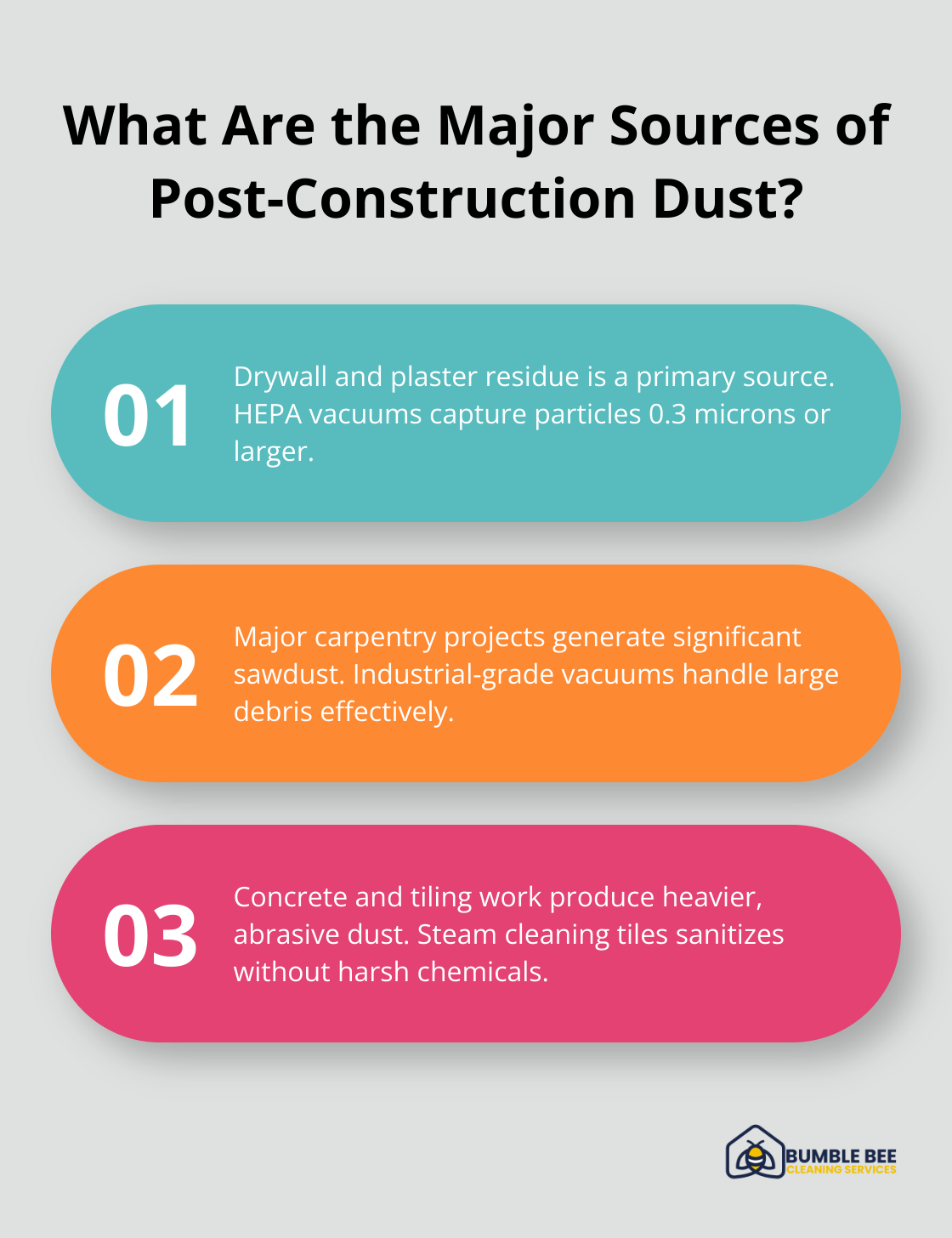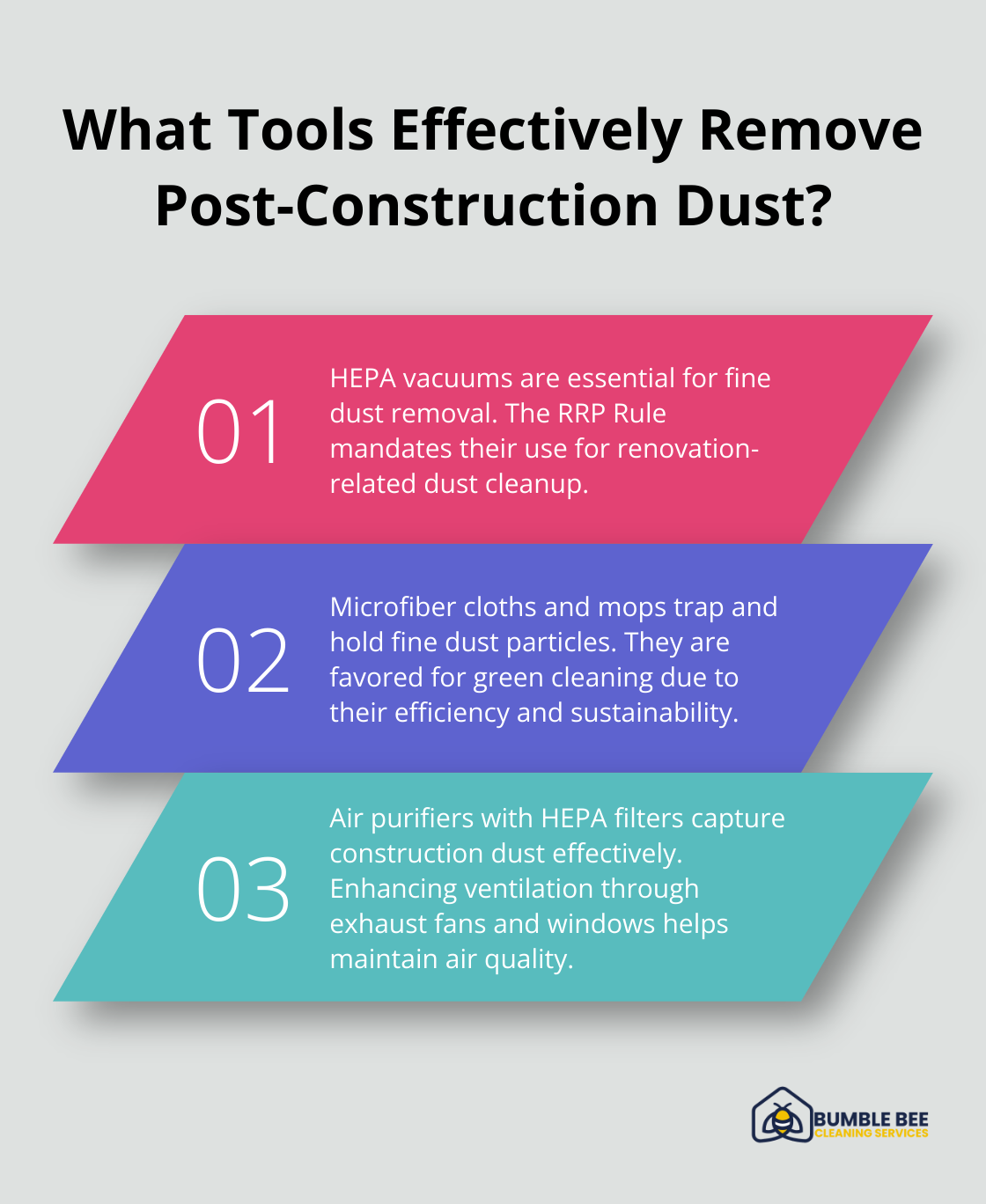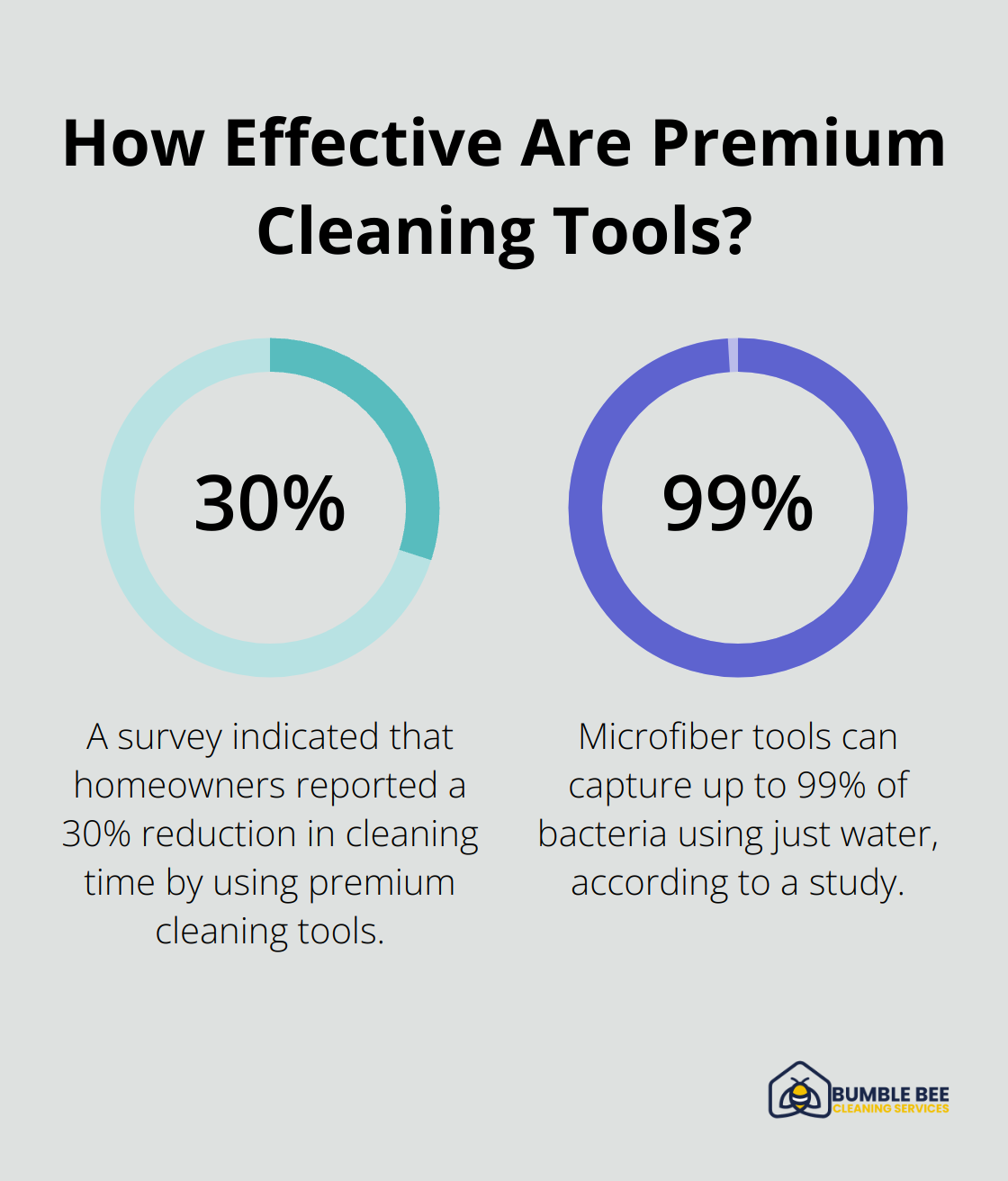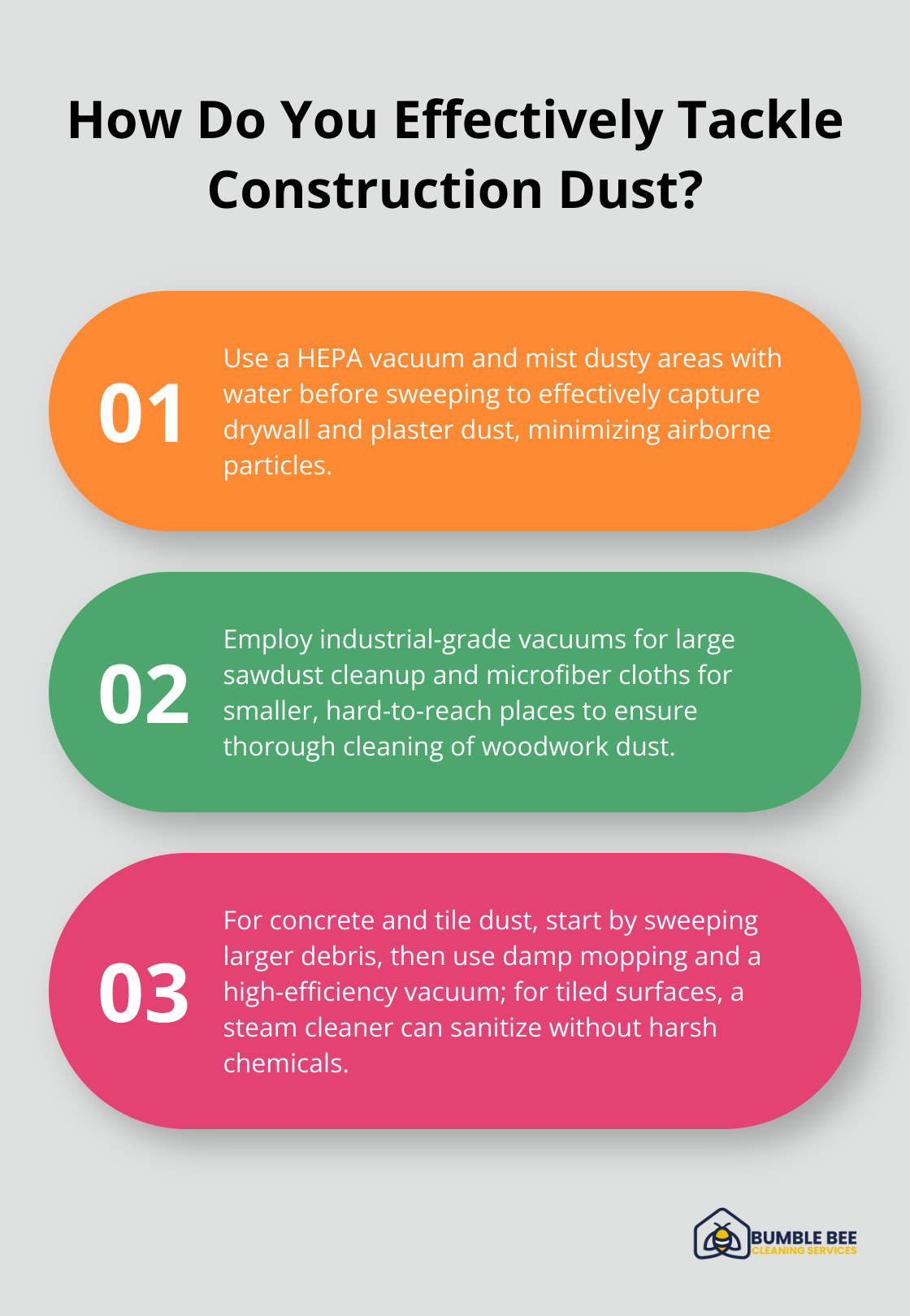Post-construction dust can be a major headache for homeowners and businesses alike. The cleanup process requires attention to detail and the right tools.
We at Bumble Bee Cleaning Services know the importance of a thorough cleaning routine after construction work.
Our practical tips will help you tackle dust efficiently and ensure a safe living or working environment.
Where Does Post-Construction Dust Come From?
Identifying the sources of post-construction dust is essential for efficient and thorough cleaning. This knowledge will guide our cleaning strategy and ensure we capture all that pesky dust.
Drywall and Plaster Residue
One primary source of post-construction dust is drywall and plaster residue. This type of dust is particularly fine and can spread throughout the entire home or office space. To tackle drywall and plaster dust, use a HEPA vacuum, which captures even the smallest particles. According to a study by the EPA, HEPA vacuums can trap particles that are 0.3 microns or larger, making them an excellent choice for this task. Additionally, it’s effective to lightly mist dusty areas with water before sweeping to reduce airborne particles. For more detailed steps, check out this post-construction cleaning checklist.
Sawdust from Woodwork
Woodwork generates a significant amount of sawdust, especially after major carpentry projects. Sawdust can settle on surfaces and in hard-to-reach places. The first step in managing sawdust is to use an industrial-grade vacuum. These vacuums are designed to handle larger debris and are more powerful than household models. For furniture and smaller nooks, microfiber cloths are highly effective. A 2019 study noted that changing trends in environmentally friendly cleaning methods are currently influencing the microfiber cloths for green cleaning; they’re not only efficient but also eco-friendly.
Dust from Concrete and Tiles
Working with concrete and tiling results in a particular type of dust that is heavier and can be abrasive if not handled properly. Start by sweeping up larger chunks and debris. Then, use a combination of damp mopping and a high-efficiency vacuum. For tiled surfaces, a steam cleaner can be a game-changer. It not only cleans but also sanitizes without the need for harsh chemicals. Steam cleaning has the added advantage of reducing allergens, a benefit supported by various health studies. For more insights on maintaining cleaning efficiency and equipment, you can refer to the Seattle Cleaning Supplies Guide.

Understanding these common sources of dust helps in planning a comprehensive cleaning approach that targets every particle effectively. By knowing where the dust originates, tools like HEPA vacuums, microfiber cloths, and steam cleaners become invaluable in the post-construction cleanup process.
What Tools Are Best for Dust Removal?
Choosing the right tools for post-construction dust removal is essential for ensuring a pristine and healthy environment. Here’s a look at effective equipment that gets the job done.
High-Efficiency Particulate Air (HEPA) Vacuums
HEPA vacuums are the gold standard for dust removal. According to a study by the EPA, the Renovation, Repair, and Painting (RRP) Rule requires HEPA vacuums to be used for cleaning up the dust created by renovations. This makes them perfect for the fine dust generated during construction. When choosing a HEPA vacuum, consider one with strong suction power and a sealed design to prevent dust from escaping.
Microfiber Cloths and Mops
Microfiber cloths and mops are incredibly effective for trapping fine dust particles. These tools are known for their ability to pick up and hold onto dust without spreading it around. A 2019 study highlighted that microfiber cloths are increasingly favored in green cleaning practices for their efficiency and sustainability. Using these cloths with a light mist of water can further reduce the amount of airborne dust. For delicate surfaces, refer to Seattle Estate Cleaning.
Air Purifiers and Ventilation Systems
Investing in a high-quality air purifier can make a significant difference in maintaining indoor air quality post-construction. Look for purifiers equipped with HEPA filters, as they are proven to effectively capture construction dust particles. Additionally, enhancing your space’s ventilation through regular use of exhaust fans and opening windows can help keep the air fresh and reduce dust accumulation.

By integrating these tools into your cleaning routine, you can efficiently manage and reduce post-construction dust, creating a cleaner and healthier space.
How to Remove Dust Efficiently
Establishing a cleaning timeline is crucial when dealing with post-construction dust. Starting with a clear plan helps manage the process systematically. Begin by scheduling an initial deep clean immediately after the construction ends. Follow up with regular touch-ups over the next few weeks to handle residual dust that settles later. A survey by HomeAdvisor in 2022 indicated that homeowners who invest in premium cleaning tools report a 30% reduction in cleaning time, making the process more manageable.
Clean from Top to Bottom
Always clean from top to bottom. Dust naturally settles downwards, so starting high and working your way down ensures you don’t recontaminate cleaned areas. Begin with ceiling fixtures, such as lights and fans, and move towards the walls, windows, and finally the floors. A study by the American Cleaning Institute found that cleaning this way reduces the amount of rework needed, enhancing overall efficiency.

When dealing with vertical surfaces like walls and windows, use a microfiber cloth to wipe them clean. This material is excellent at trapping dust rather than just redistributing it. For floors, vacuum thoroughly using a HEPA vacuum to capture fine particles.
Proper Disposal of Dust and Debris
Proper disposal of dust and debris is essential. Use a vacuum with a sealed bag to prevent dust from escaping back into the air. Dispose of vacuum bags in a sealed trash bag to contain the dust. Larger debris should be bagged separately and taken to appropriate waste disposal facilities.
Use damp mopping for hard floors to pick up any remaining dust particles. Opt for microfiber mops as they are more effective and environmentally friendly. According to a 2019 study favoring green cleaning products, microfiber tools can capture up to 99% of bacteria using just water, which supports their effectiveness in post-construction cleaning.
In conclusion, establishing a timeline, cleaning from top to bottom, and disposing of dust properly are key strategies to tackle post-construction dust efficiently. These methods ensure a cleaner and healthier environment for all occupants.
Wrapping Up
Thorough dust removal after construction isn’t just a matter of cleanliness—it’s vital for health and safety. Using the right tools and techniques, like HEPA vacuums, microfiber cloths, steam cleaners, and air purifiers, makes a significant difference in the quality of the cleanup. Cleaning from top to bottom and ensuring proper disposal of dust helps maintain a healthy environment by minimizing airborne particles and allergens.

Regular cleaning schedules and appropriate maintenance routines prevent residual dust buildup, ensuring a cleaner and safer space over time.
Experience comprehensive post-construction cleaning with Bumble Bee Cleaning Services. Our expert team serves the Greater Seattle and Atlanta Areas with exceptional results using eco-friendly products. From one-time projects to regular maintenance, we tailor our flexible plans to meet your specific needs, all while supporting the Seattle Children’s Autism Center with every service. Relax and enjoy a pristine living or working environment with Bumble Bee Cleaning Services, your partner in professional cleaning.
